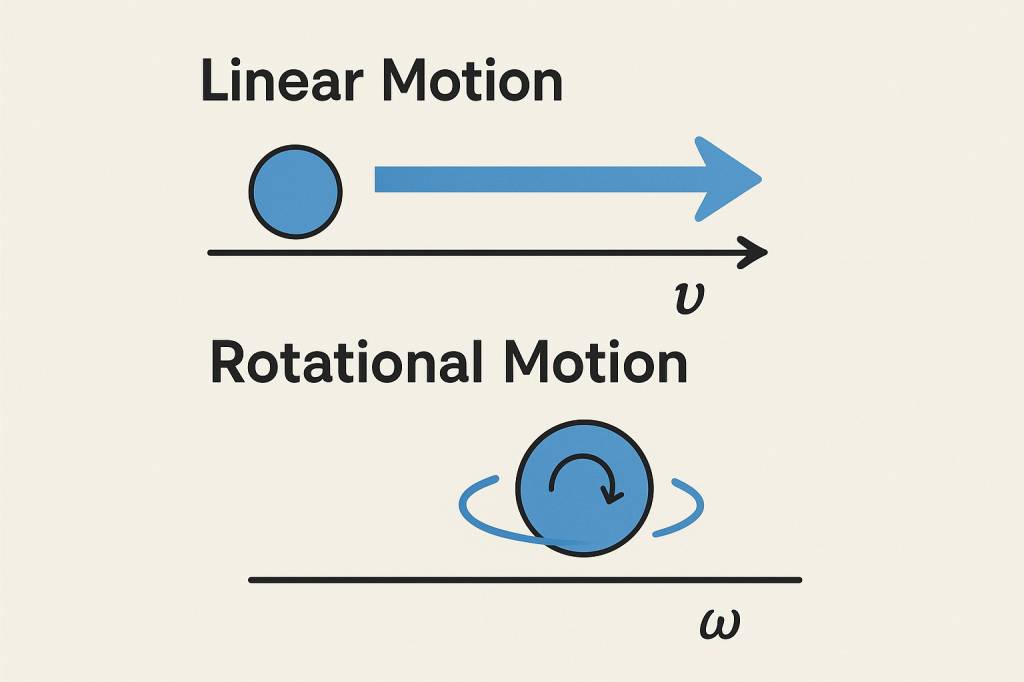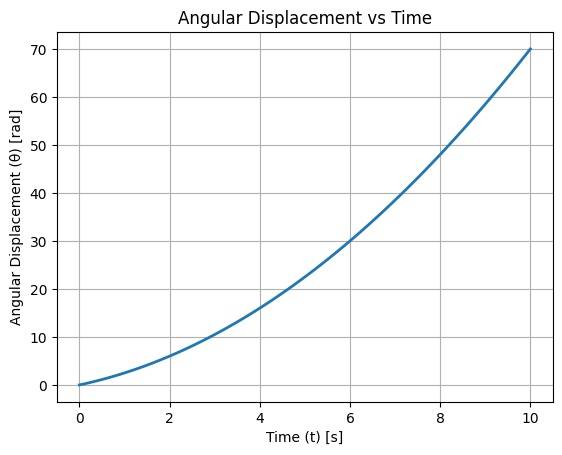
Next topic which we will cover under the chapter systems of particles and rotational motion is rotational kinematics. Kinematics of rotational motion can be described as a branch of mechanics that deals with observing the motion of an object in rotation without taking the external forces into consideration, which in turn leads to the motion of that particular object.
Learning the basic concepts of this principle will help us track the movement of the object such as how fast the object is rotating and the rate of change of object's speed at a particular instant. Continue reading the article for more details related to Kinematics of Rotational Motion.
Also Read:
| Class 11 Physics Notes | Class 12 Physics Notes |
| System of Particles and Rotational Motion NCERT Solutions | System of Particles and Rotational Motion NCERT Exemplar |
- What is Rotational Motion?
- Some Key Quantities
- Kinematic Equations for Rotational Motion
- Moment of Inertia
- Comparison with Linear Motion
- Practical Applications
- Class 11 NCERT Revision Notes
- Class 11 NCERT Solutions
What is Rotational Motion?
The motion of an object can be divided into two categories:
- Moving from one point to another (called linear motion)
- Rotating around a fixed axis (called rotational motion)
Rotational motion is referred to as the motion which occurs when the body rotates around a fixed axis unlike linear motion in a straight line. The object rotates around a stationary point or line called the axis of rotation. Each particle of the object moves in a circular path with axis being the centre point. How far the centre axis is from the particle will determine the radius of the circle. Some common examples include a spinning top, earth revolving around the sun, moving fan, hands of a clock, etc.
To study this topic briefly, you need to be familiar with some key terms which we have covered in the article further. Continue scrolling!
Some Key Quantities
In rotational motion about a fixed axis, the motion is described using angular quantities and concepts which are explained as follows:
Angular Displacement :
Angular Displacement is referred to the angle at which the object rotates around the fixed point of axis. The formula for angular displacement is:
θ = θf - θi
Where,
θ = angle of displacement
θi = angle of initial position
θf = angle of final position
It is a vector quantity and is measured in radians.
Angular Velocity :
Angular Velocity is the measure of the speed of rotation of a particular body. It can be represented by the mathematical equation:
Where,
ω = angular velocity
dθ/dt = rate of change
It is a vector quantity and SI unit of angular velocity is radian per seconds.
Angular Acceleration :
Angular Acceleration is referred to the rate of change in the acceleration of the object. Just as linear acceleration describes how fast the velocity of an object changes from one point to another, angular acceleration tells us how fast the object moves around its fixed point of axis. It can be denoted through the formula:
Where,
α = angular acceleration
ω = angular velocity
t = time
The SI Unit for angular acceleration is .
Torque :
Torque is considered as the rotational equivalent of force and measures the force applied on the object rotating on the axis. it is caused by external forces acting at a distance from the axis, and the moment of inertia quantifies the body's resistance to angular acceleration.
Mathematical Representation:
Where,
= net external torque about the axis,
= moment of inertia of the body about the axis
= angular acceleration.
SI unit of torque is .
Kinematic Equations for Rotational Motion
There are some important formulas which need to be kept in mind while diving into the world of kinematics, known as kinematic equations. In the case of constant angular acceleration, the kinematic equations mirror those of linear motion. For such scenarios, the following equations can be used:
Here, is the initial angular displacement, is the initial angular velocity, and is the constant angular acceleration.
Now let us have a look at the derivations of each of these equations in detail.
1st Equation of Rotational Motion
First of all, α=dω/dt
Integrating both the sides, we get
ω−ω0=αt
ω=ω0+αt
Hence, Proved!
2nd Equation of Rotational Motion
According to the equation of angular velocity:
ω=dθ/dt
On substituting ω from the first equation and integrating both sides, the resulting equations turns out to be:
dθ/dt = ω0+αt
θ = ω0t+1/2αt^2
Hence, Proved!
3rd Equation of Rotational Motion
α=dω/dt (1)
ω=dθ/dt (2)
Now,
α=dtdω=dθdω⋅dtdθ=dθdω⋅ω
αdθ=ωdω
Integrate the above equation and get:
αθ = 1/2ω^2−1/2ω0^2
Now multiply both sides by 2:
2αθ=ω2−ω02
2αθ + ω02=ω2
Hence, Proved!
Moment of Inertia
Just as we use the terms mass of an object in linear motion, moment of inertia is the terms used in scenarios involving rotational motion. Yes, it is known as the rotational equivalent of mass in linear motion and is used to calculate the resistance shown by an object while changing its motion.
For a system of particles, moment of inertia will be represented as:
Where,
I = Moment of Inertia
Mi = Mass of the body
Ri = Distance from the axis
For continuous bodies, it can be presented as:
Comparison with Linear Motion
Know More About: NCERT Chapter 6: Systems of Particles and Rotational Motion
Practical Applications
Kinematic equations are applied to numerical problems involving rotating objects like fans, pulleys, or discs etc. Apart from these, there are also numerous real world uses of this concept which have assisted in the invention and development of various modern day technologies which help in the advancement of technology. Here are a few key applications of rotational motion in the real world:
- Motors and Engines
- Automobiles
- Biomechanics
- Sports
- Gyroscopes
- Transportation
- Astronomy
Class 11 NCERT Revision Notes
Here are some important accumulated topics and their notes which will help you prepare for JEE MAINS effectively.
| Units and Measurements Class 11 Notes | Mechanical Properties of Solids Class 11 Notes |
| Motion in a Straight Line Class 11 Notes | Mechanical Properties of Fluids Class 11 Notes |
| NCERT Class 11 Notes for Motion in a Plane | Thermal Properties of Matter Class 11 Notes |
| Laws of Motion Class 11 Notes | Thermodynamics Class 11 Notes |
| Work, Energy, and Power Class 11 Notes | Kinetic Theory of Gas Class 11 Notes |
| System of Particles and Rotational Motion Class 11 Notes | Oscillations Class 11 Notes |
| Gravitation Class 11 Notes | Waves Class 11 Notes |
Click Here:
| NCERT Class 11 Notes for PCM |
| NCERT Class 11 Physics Notes |
Class 11 NCERT Solutions
Commonly asked questions
What is Centripetal Acceleration?
This is the type of acceleration due to which a circular moment of the object is possible. This force constantly directs the motion of the body towards the centre of gravitation. Without this motion, the object will move away in a straight line. It ensures that the object stays in a circular path by changing the direction of object's velocity towards the centre.
Why do we use radians instead of degrees as the unit of measurement in rotational kinematics?
This is because using radians will simplify the procedure of solving various numerical problems and complex mathematical equations. They help consider the terms such as arc length, centre, radius etc. directly into account which are connected to a circular path which eases our task of computing the formulas.
Why are the graphs of rotational motion mostly similar to the ones in linear motion?
This is because the terms used in rotational motion are analogous to the terms used in linear motion and can interchange each other with variation in the topic since their meaning is exactly the same. For example, what you call force in linear motion can be called torque in terms of rotational motion. Just replace the linear terms with angular terms and you are done with the major process.
Physics System of Particles and Rotational Motion Exam
Student Forum
Other Topics under this Chapter
- Overview
- Moment of Inertia
- Centre of Mass
- Motion of Centre of Mass
- Vector Product of Two Vectors
- Torque and Angular Momentum
- Equilibrium of a Rigid Body
- Linear Momentum of a System of Particles
- Angular Velocity and Relation with Linear Velocity
- Kinematics of Rotational Motion About a Fixed Axis
- Dynamics of Rotational Motion About a Fixed Axis
- Angular Momentum of Rotation About a Fixed Axis
- Streamline Flow
Other Class 11th Physics Chapters
- Physics Mechanical Properties of Solids
- NCERT Class 11 Physics
- NCERT Class 11 Notes
- NCERT Notes
- Physics Motion in Plane
- Physics Mechanical Properties of Fluids
- Physics Motion in Straight Line
- Physics System of Particles and Rotational Motion
- Physics Oscillations
- Physics Waves
- Physics Thermal Properties of Matter
- Physics Motion
- Physics Gravitation
- Physics Thermodynamics
- Physics Work, Energy and Power
- Physics Units and Measurement
- Physics Laws of Motion





